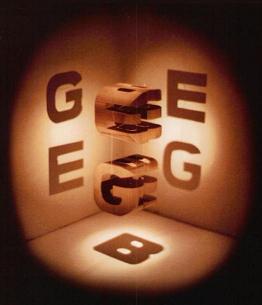
|
|
Vinnie Mancuso, in an article now dated December 25, 2018 —
Related art —
Click image for further details.
The Log24 version (Nov. 9, 2005, and later posts) —
|
VERBUM
|
See also related material in the previous post, Transformers.
"Sharpie, we have condensed six dimensions into four,
then we either work by analogy into six, or we have to use math
that apparently nobody but Jake and my cousin Ed understands.
Unless you can think of some way to project six dimensions into three–
you seem to be smart at such projections."
I closed my eyes and thought hard. "Zebbie, I don't think it can be done.
Maybe Escher could have done it."


“… I realized that to me,
Gödel and Escher and Bach
were only shadows
cast in different directions by
some central solid essence.
I tried to reconstruct
the central object, and
came up with this book.”
Related images —


Continued from April 18 .
"Working with words to create art
and working with your hands to create art
seem like two separate activities to me."
— Cover artist, The New Yorker , on April 17
See also Alphabet Blocks in this journal
as well as Escher's Verbum.
|
|
"The creation of a new world
starts now.
Once again I am tied
to the logic of this
Hyper-symmetrical-dimension."
A sequel to the 1974 film
Thunderbolt and Lightfoot :
Contingent and Fluky
Some variations on a thunderbolt theme:
These variations also exemplify the larger
Verbum theme:


A search today for Verbum in this journal yielded
a Georgetown University Chomskyite, Professor
David W. Lightfoot.
"Dr. Lightfoot writes mainly on syntactic theory,
language acquisition and historical change, which
he views as intimately related. He argues that
internal language change is contingent and fluky,
takes place in a sequence of bursts, and is best
viewed as the cumulative effect of changes in
individual grammars, where a grammar is a
'language organ' represented in a person's
mind/brain and embodying his/her language
faculty."
Some syntactic work by another contingent and fluky author
is related to the visual patterns illustrated above.
See Tecumseh Fitch in this journal.
For other material related to the large Verbum cube,
see posts for the 18th birthday of Harry Potter.
That birthday was also the upload date for the following:
See esp. the comments section.
David Levine's portrait of Arthur Koestler (see Dec. 30, 2009) —



See also this morning's post as well as
Monday's post quoting George David Birkhoff —
"If I were a Leibnizian mystic… I would say that…
God thinks multi-dimensionally — that is,
uses multi-dimensional symbols beyond our grasp."

(Cover slightly changed.)
Background —
SAT
Part I:
Part II:
 |
Part III:
From August 25th —

"Boo, boo, boo,
square root of two."
Detail from
Escher’s Verbum
(“In Touch with God“)
The title link of this entry
leads, via a Log24 entry, to
a story by Robert A. Heinlein.
For those who, like Rick Warren
(shown below in a current news page),

prefer Jewish narratives,
I recommend
1. Kesher Talk’s “Dick Morris:
Flaming Sword of Vengeance“
3. Triangulation.

Greetings.
“The greatest sorcerer (writes Novalis memorably)
would be the one who bewitched himself to the point of
taking his own phantasmagorias for autonomous apparitions.
Would not this be true of us?”
–Jorge Luis Borges, “Avatars of the Tortoise”
“El mayor hechicero (escribe memorablemente Novalis)
sería el que se hechizara hasta el punto de
tomar sus propias fantasmagorías por apariciones autónomas.
¿No sería este nuestro caso?”
–Jorge Luis Borges, “Los Avatares de la Tortuga“
At Midsummer Noon:
|
|
It is not enough to cover the rock with leaves. We must be cured of it by a cure of the ground Or a cure of ourselves, that is equal to a cure
Of the ground, a cure beyond forgetfulness.
And if we ate the incipient colorings – Wallace Stevens, “The Rock” |

(Title of an interview with
the late Paul Halmos, mathematician)
From a 1990 interview:
“What’s the best part of being a mathematician? I’m not a religious man, but it’s almost like being in touch with God when you’re thinking about mathematics. God is keeping secrets from us, and it’s fun to try to learn some of the secrets.”
I personally prefer Annie Dillard on God:
“… if Holy the Firm is matter at its dullest, Aristotle’s materia prima, absolute zero, and since Holy the Firm is in touch with the Absolute at base, then the circle is unbroken. And it is…. Holy the Firm is in short the philosopher’s stone.”
Some other versions of
the philosopher’s stone:

This last has the virtue of
being connected with Halmos
via his remarks during the
“In Touch with God” interview:
See also the remark of Halmos that serves as an epigraph to Theme and Variations.

has also served
at least one interpreter
as a philosopher’s stone,
and is also the original
“Halmos tombstone.”
In memory of Humphrey Carpenter, author of The Inklings, who attended The Dragon School. Carpenter died a year ago today.
"Lewis began with a number of haunted images…."
"The best of the books are the ones… where the allegory is at a minimum and the images just flow."
"'Everything began with images,' Lewis wrote…."

From Paul Preuss,
Broken Symmetries
(see previous entry):
From
Verbum Sat Sapienti?


Powered by WordPress